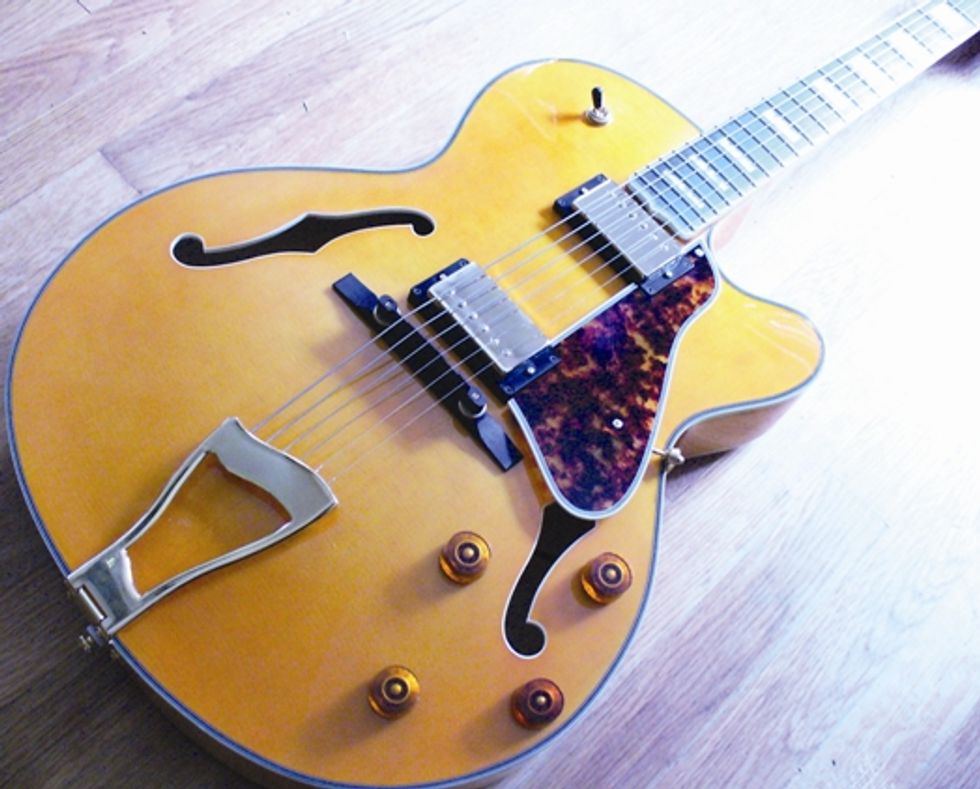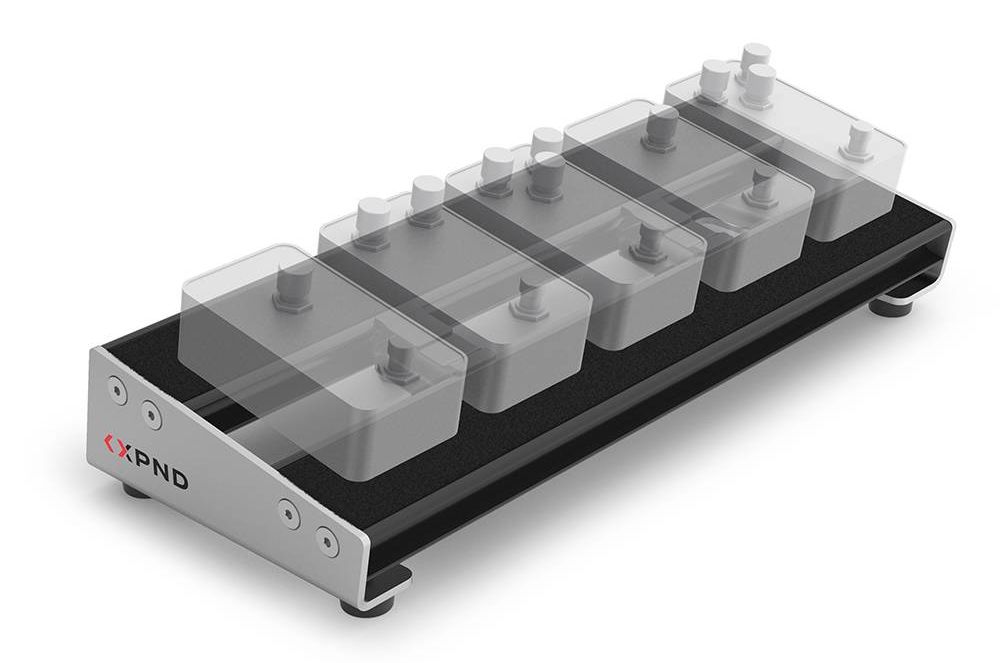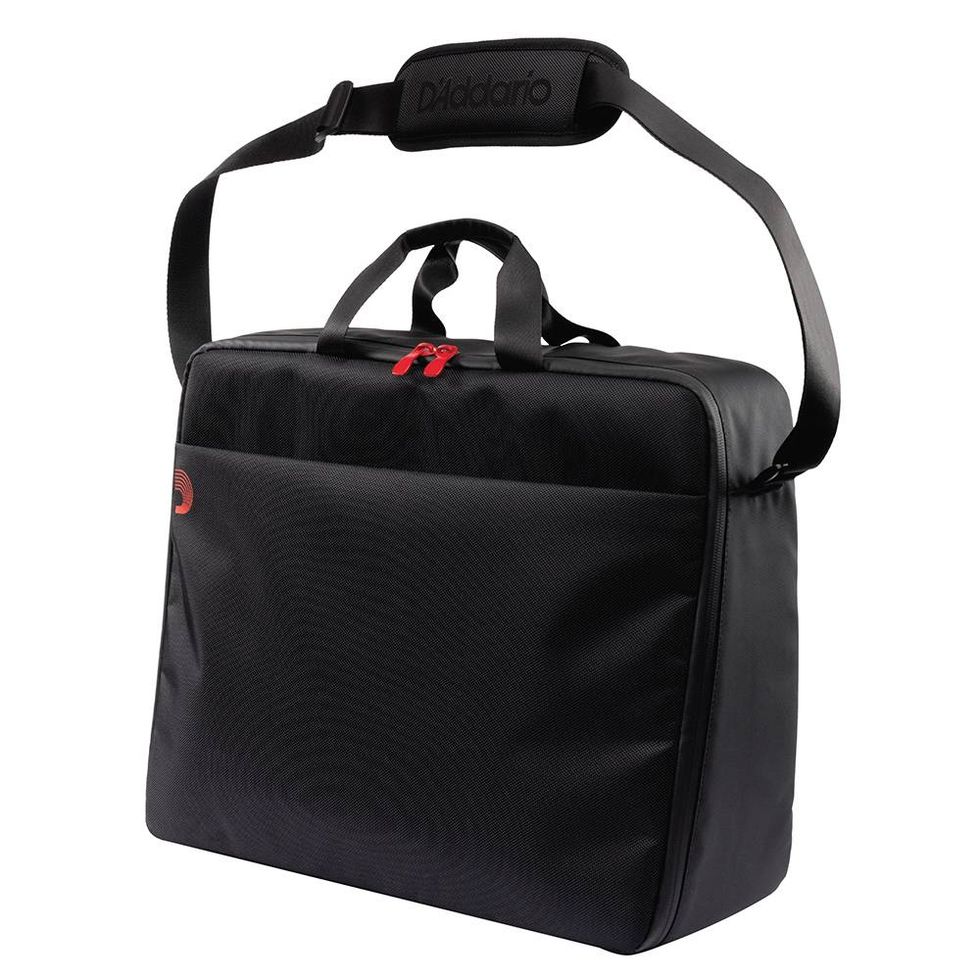 |
Many serious contenders have joined the battle for the $1000-$1400 niche in factory-built archtops. The fully-hollow Stromberg Montreux is a serious up-and-comer and more than ready to join the fray. Designed by WD Music, the guitar is distributed from their Florida facility. Armed with a strong customer service arsenal, as well as impressive research and development, WD seems ready to take on major contenders in this arena, including other import brands such as Eastman, D’Angelico and Ibanez. Among U.S. manufacturers, there simply aren’t any quality archtops in that price range.
What’s In A Name
An examination of WD’s line must begin with a little history of the Stromberg name, a family that was famous for making acoustic archtops in the thirties and forties. These guitars were sought-after in their pre-amplification day for their ability to be heard over an entire dance orchestra without amplification. Count Basie’s guitarist, Freddie
Green, was a well-known player of Strombergs. Between 1932 and 1964, Charles and son Elmer Stromberg sold highend, handmade instruments bearing their name, making just over 700 instruments.
"Regardless of what’s in a name, the new Stromberg guitars are a roaring success on the most important fronts, starting with size and feel and ending with price."
The Stromberg name laid dormant for many decades until WD Music acquired it several years ago. Their goal – according to their website – is to make a professional grade archtop guitar at an attractive price. They do not seem to claim any other connection to the Stromberg name, other than using it as an already-established marque connected to a tradition of making fine guitars. One might wonder why there are not more appointments on the “new” Stromberg that more closely match the early Stromberg designs, but for whatever reason, such are all but absent.
Regardless of what’s in a name, the new Stromberg guitars are a roaring success on the most important fronts, starting with size and feel and ending with price. My examination dealt solely with the Stromberg Montreux model, which has two routed humbuckers and L-5-esque stylistic cues. The guitar matches all the dimensions that have been accepted as the epitome of a modern, comfortable jazz guitar. These include the 1 11/16” nut, a Gibson-style wide-flat early-sixties neck profile, a scale length just a hair shorter than an L-5 and a mid-size 16.5” lower bout, combined with the modern trend to go a bit thinner in the rim depth at 2 5/8”. The more impressive of the parts include Kent Armstrong PAF humbuckers, Kluson Deluxe tuners, and a handmade-in-the-U.S. tortoiseshell pickguard. The tailpiece, knobs, pickguard bracket and bridge are the import type that can be seen at many distributors’ websites. The quality of these parts is acceptable if not slightly yawn inducing. The latter reminds us that it is a chore to make a guitar of this quality in the stated price range – some aspects must be scaled down. The company does say they are in the process of tooling for an original Kluson tailpiece that will be used on future models.
The example that I tried out is suggestive of excellent quality control, demonstrated by its fantastic action with the standard factory setup with .012 gauge flatwound strings. I was impressed with the straight neck and with how well it played with close action. Many newer, higher-end Gibson archtops I have handled do not play as well. A unique two-way truss rod system may be responsible for this. My respect for the guitar grew even larger after several hours of play, easily capturing a warm PAF tone from the Kent Armstrong pickups. The high-end electronics work flawlessly and I found the pickups capable of producing a mellower tone than Gibson’s Reissue ‘59 pickups, which often sound too harsh and bright. The guitar comes to the buyer following a serious numbered inspection and setup regimen – complete with your preferred gauge of strings. This guitar could be carried straight to the gig with no additional fuss. Customer service is a real plus with this purchase.
By contrast, players who prefer their guitars to be adorned sans pickguard will not be affected as the pickguard is essentially out of the way [the company says an L-5 style pickguard is available as a custom option at no extra cost].
 |
The joinery seems surprisingly very good and I could find no flaws. Binding imperfections are minute compared to most other import guitars. The clear coat is too thick – a problem shared by many import guitars – but is not as heavy as most I have seen and is acceptable. Finish imperfections, which are always typical on any factory instrument, seemed to be less severe than those found on most new U.S. archtops.
Some serious thought also went into the neck design on these models. The website describes a new system of neck construction and neck-set design which is intended to eliminate future problems of ‘lift’ in the neck extension (highest frets). Many guitars today have joined headstocks and necks. Companies like Taylor use a fingerjoint which I find to look machined and unattractive; in contrast to that, the Stromberg uses a neck/headstock “scarf” joint that is hard to detect and ultimately much more appealing. The fingerboard quality is fine and the fit of the multiple binding on the neck – a tricky undertaking – is impressive. The nicely crafted inlays are not overstated, which combined with gold hardware, give the guitar an aura of simple, L-5-like elegance. Personally, I would prefer a better- working Grover tuner with Imperial buttons over the provided Klusons, which seem more appropriate for Epiphone and Gibson mid-level models.
My chief complaint has to do with the pickguard design and mounting. The guard – unsurpassed in quality – is designed more like an ES-335 guard, lying almost flat on top of the guitar while being routed to go around the pickup rings. This places the guard much lower than where it needs to be, creating a “cliff” beyond the strings – a design which seems more appropriate for thinline guitars rather than full-depth archtops. Jazz players who rely on a Johnny Smith right-hand style will find this design bothersome. The solution would be to mount the pickguard on top of the pickup rings, L-5 style.
The Final Mojo
The new Stromberg forces us to rethink Korea’s ability to make a quality guitar, something previously only available from Japan. Regarding fit and finish, the instrument seems to be easily ahead of its peers in this price range. For myself, once I remedied the pickguard issue, I would happily play the Montreux at any straight-ahead jazz gig and feel very inspired by the fantastic playability and authentic warm PAF tone. Overall, I find the Stromberg to be very impressive and a real value for serious students of jazz as well as professional players on a budget. The last smile of the day is drawn from the very nice TKL case that comes as standard equipment, as well as a nifty accessory pack.
Buy if...
you want the best bargain available in a pro-level archtop guitar
Skip if...
you are troubled by the use of the Stromberg name on a too-distant Asian cousin
Rating...
MSRP $1295 - WD Music - stromberguitars.com |
Our expert has stated their case, now we want to hear yours. Share your comments and ratings below.



















![Rig Rundown: Russian Circles’ Mike Sullivan [2025]](https://www.premierguitar.com/media-library/youtube.jpg?id=62303631&width=1245&height=700&quality=70&coordinates=0%2C0%2C0%2C0)






